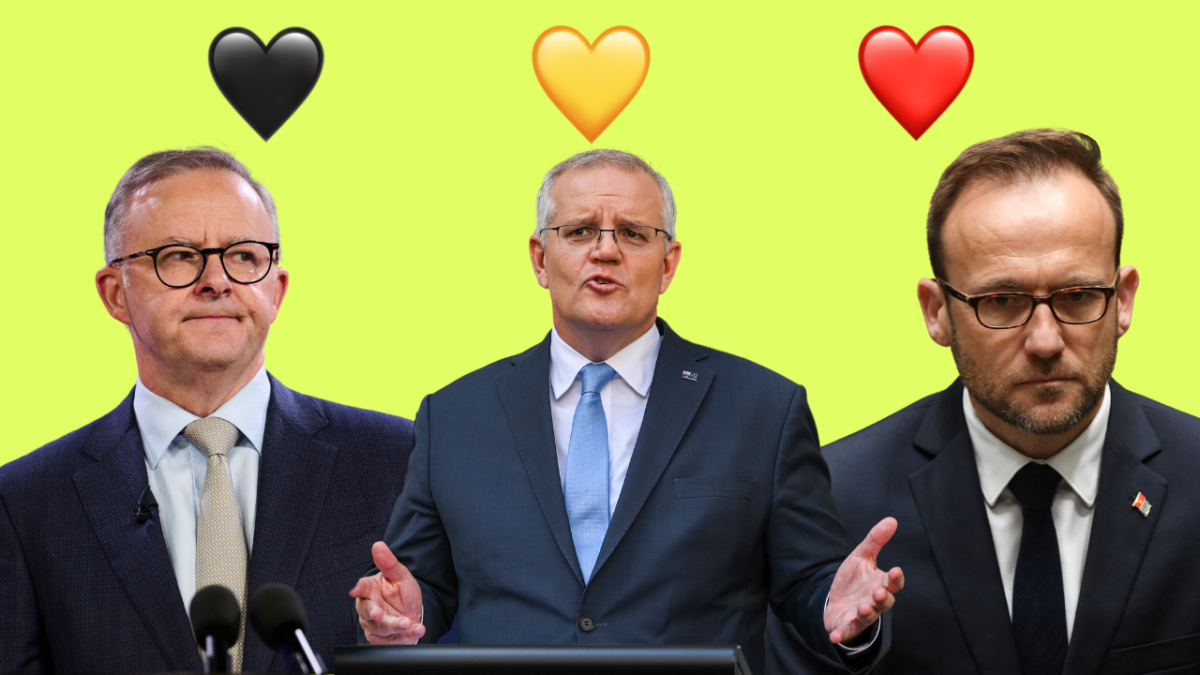
The countdown to election day is on and because the Coalition’s held power for almost a decade, this is Australia’s big chance for change. So we’re here to help you understand and compare each major party’s First Nations policies and lay it all out without the political spin.
NOTE: promises are often broken so we’ve also prepared a little look back at the voting track records of Scott Morrison, Anthony Albanese and Adam Bandt — because what they do speaks louder than their words.
We’ll compare the Coalition, Labor and the Greens’ policies on all the issues important to young people.
We’ve narrowed them down to: climate change, the cost of living and housing, women’s rights, LGBTQIA+ rights, First Nations rights, mental health and education.
After a couple of huge years for the movement against Indigenous deaths in custody and for Black Lives Matter, let’s see if any of the major parties have listened.
The Coalition’s First Nations Policy
When the Morrison Government released its 2022-23 budget, it called the Indigenous portfolio measures some of the most ambitious we’ve ever seen.
The policies focused on “empowering Indigenous Australians, creating jobs, building skills and unlocking the economic potential of Indigenous land,” Minister for Indigenous Australians Ken Wyatt said.
Hmm, sounds like the government wants to let mining companies blow up more sacred sites. But anyway let’s take a look.
The government promised $636.4 million to fund an estimated 2,000 new ranger jobs (on top of the 2,100 there are now) in regional and remote areas over the next six years for land management and controlled burning.
If re-elected the Indigenous Business Australia’s Indigenous Home Ownership Program would be extended by two years, creating 1,000 jobs and giving around 1,600 families access to home loans. Not giving them homes, just giving them loans.
There are also some small sums dedicated to mentoring programs for workers and remote engagement programs.
The other side of the coin is that it would also continue to fund its controversial and costly Community Development Program for people in remote areas which has been described as punitive, ineffective and racist because it forces First Nations people to work for well below minimum wage.
“People are forced into 25 hours worth of labour a week, five days a week. They’re excluded from the fair work act, they’re not employees,” ACTU National Campaign Coordinator Kara Keys told NITV News.
In 2022-23 the government also estimated it would provide $16.2 million to the states for programs to improve the health of First Nations people — which is actually a slight decrease on the previous year.
The government also committed more money to federal police resources and staffing and has a whole policy to “tackle youth crime and anti-social behaviour in Alice Springs”.
It includes more CCTV around the city ($600,000), facilitate more local diversionary activities ($3.9 million), create more community patrols, more often ($4 million) and deliver a new Head to Health mental health service ($3.4 million).
So it seems no, the government has not been listening to what First Nations communities want.
Labor’s First Nations Policy
Labor does have a First Nations policy going into this election which has several big initiatives.
Most significantly it has pledged to implement the Uluru Statement from the Heart in full. The Uluru Statement was created and signed by more than 250 First Nations delegates in 2017 and called for the “establishment of a First Nations Voice enshrined in the Constitution”.
Labor promised to “progress” a referendum to constitutionally enshrine a Voice to Parliament “as a matter of priority”, but hasn’t said when or what that actually means. It also said it would establish a Makarrata Commission to work with the Voice to Parliament on a national process for treaty and truth-telling. But it hasn’t necessarily committed to a treaty anytime soon.
Labor’s policy also addressed that more than 500 First Nations Australians have died in custody since the Royal Commission into Aboriginal Deaths in Custody more than 30 years ago. In response, it promised to establish locally tailored justice reinvestment initiatives and Aboriginal and Torres Strait Islander legal services in 30 communities.
If elected it would also scrap the Community Development Program and replace it with a new employment program developed in partnership with First Nations people.
There’s also money to double the number of First Nations rangers for better land and waters management (about the same as the Libs) and it has promised to strengthen protection of First Nations intellectual property to get rid of the fake art market.
The Greens’ First Nations Policy
The language in the Greens’s First Nations policy is pretty different to Labor’s. Not only does it start with an acknowledgement of invasion and that sovereignty was never ceded, it’s focused the policy on immediately establishing a treaty, healing and truth-telling. And there’s a lot of money for it.
It’s pledged $250 million for a national Truth and Justice Commission — an independent body with the powers of a Royal Commission — to investigate and reveal historic and ongoing human rights abuses, $371 million would go to self-determined First Nations health services to increase their capacity to care for their own communities and $1.07 billion to build First Nations-owned healing places.
It would also establish compensation scheme to provide Stolen Generations survivors with a $200,000 payment each and commit $767 million to expand the First Nations ranger programs and Indigenous Protected Areas.
On Friday it announced a $144 million fund for five dedicated birthing on country hubs across Australia to improve culturally appropriate healthcare.
Pretty good stuff.



